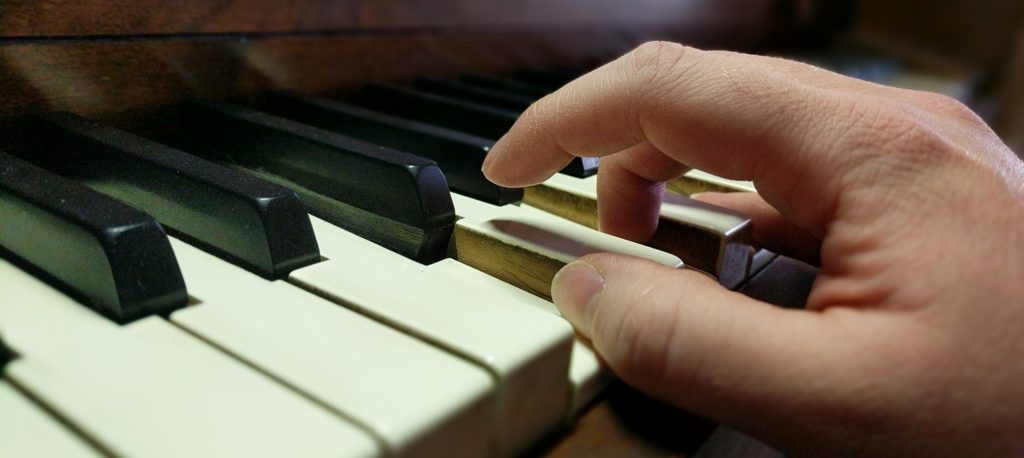When most people think of a piano, they think ivory keys. The idea of “stroking the ivory keys” has been a romantic notion for many years!
But are piano keys actually made of ivory? A thin layer on top and in front of a piano key used to be made out of ivory up into the 1940’s. Since the 1940’s, piano keys are made of wood, plastic, ebony, and sometimes resin. Most of the white key is made of wood and then a thin layer of plastic covers the top and sometimes the front of the key. The black keys of a piano are made of ebony.
Piano keys are still often referred to as the “ivories”, even though they aren’t made from it. But which is better – ivory or plastic keys on a piano?

Comparing Plastic to Ivory Keys on a Piano
The piano instrument as we know it today, didn’t really become popular until around the 1700’s. During that era, the piano keys were made with a thin layer of ivory on the tops and sides of the key. Piano had gained in popularity as to be found in most genteel drawing rooms.
In time, ivory became more expensive and less affordable. So plastic keys began to replace the ivory keys of a keyboard. In 1989, ivory was banned and piano keys were not made out of ivory at all.
This has given us some time to compare plastic keys to ivory keys.
Ivory keys will yellow over time. Plastic keys do not. The ivory key will yellow, but a good plastic key will still look white even in years and years to come. Cheap plastic keys will yellow over time.
Ivory keys tend to crack, to become brittle, to chip, and are easier to damage.
Ivory keys are porous, thus making it difficult to clean. Plastic keys can be cleaned with a high concentration rubbing alcohol and much of the grim and dirt can be rubbed off. Cleaning alcohol on ivory keys will work, but it will dry out the keys and have the potential to cause warping within the keys. So its encouraged to just use a lightly damp cloth.
Ivory is expensive and hard to replace. Replacing ivory keys is possible, if the technician has some on hand that match well. But replacing the keys is not always easy. If you need to replace the whole keyboard, it can cost thousands of dollars. Replacing plastic keys is much easier because it is more readily available. You can easily replace a key or two with minimal cost. If you want to replace the whole set of keys on a keyboard, it will only cost you a few hundred dollars versus the thousands of dollars needed to replace a set of ivory keys.
Ivory is banned. Ivory, taken from the husks of elephants, is a banned trade. It is illegal to buy or trade ivory in most places. Many people consider ivory unethical because of the mistreatment and waste to the elephant.
Preference. Some people really enjoy the feel, the touch, and the look of legitimate ivory keys on a piano. Some people consider it superior to the plastic keys of today. But some people find that it isn’t as suitable to the touch and feel.
Today, pianos are made of plastic keys. Steinway, considered the top brand of piano, are all made of plastic keys. So the quality of the piano is not determined by the keys being made out of ivory or plastic.
What Are Piano Keys Made Out Of Now?
There are 88 keys on a piano, 52 white keys and 36 black keys. Keys are made out of wood. The white keys are longer and thicker than the black keys on a piano. They are played more often than the black keys, and thus have a material that would last to more use.
For a white key, a thin layer of plastic is laid over the top of a hollow wooden key. Sometimes, plastic is laid over the front of the key as well. Some piano companies develop their own kind of plastic to imitate the feel and touch and look of ivory.
A black key is made of ebony. Ebony is a black hardwood. It has a dense composition. When you polish it, it produces a high quality gloss finish.
Some higher end pianos make their piano keys out of resin. Resin is an even higher quality material than the plastic and is even less prone to damage or coloring. This is more expensive to make and the benefits aren’t that much greater than plastic, so it is not often seen.
How Can I Tell What My Keys are Made Of?
You may have an older piano made before the making of ivory keys was banned. How can you tell what the keys are made of?
There are a few things that you can look for to see if you have ivory keys:
Ivory keys will have a texture, while plastic keys are smooth (usually). The ivory keys will have a finger print pattern on it if you look at it really closely. In some cases, you can find texture on a plastic key. These will be regular, predictable patterns while the ivory keys won’t have that.
Ivory will turn yellow, while plastic keys don’t.
Ivory had to be joined together, so you may see thin lines where the ivory was joined. So look for hair-thin lines in your white keys. Look for a line between the top, thin part of the white key, versus the wider part of the bottom key. This is where the ivory key would be joined together.
If you know that your piano was made before the 1930’s, then your piano likely will have ivory keys.
What Are Ivory Keys Worth?
Because ivory is banned, ivory keys aren’t worth much of anything. There is so little material to be found on the plastic key as well. It is illegal to trade and buy them most anywhere anyhow. The damage to the ivory keys over this amount of time has also decreased any value that they may have had.
Most ivory keys are given away. Piano companies will keep drawers full of ivory keys in case there is a need of replacement, but they don’t hold any value. Piano technicians may not be willing to spend the time and effort into replacing the keys if a replacement is not easily found.
You can buy a piano with ivory keys, but don’t think that the ivory on the piano keys is worth anything. It may be difficult to transport the piano anywhere far. You may need to get legal paperwork and permission before it can cross state or country lines.
Tel loves her life as a piano player, a piano teacher, and a mom. Amid piano blogging, piano teaching, and piano playing, she loves a chance to fit in a good exercise class, volunteer at her kids’ school and at her church, and go on long dates with her husband. Full bio at About Tel.


